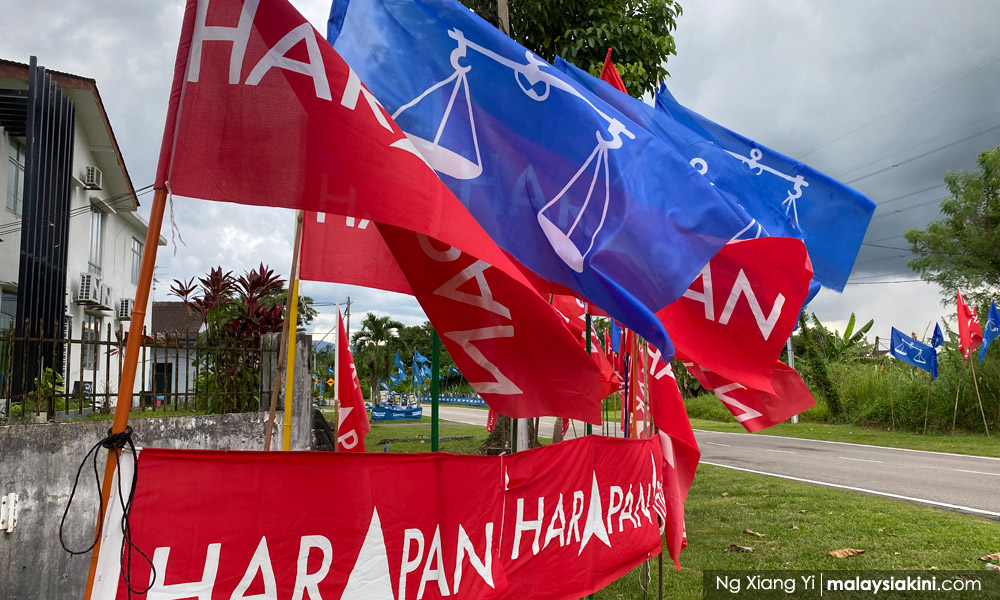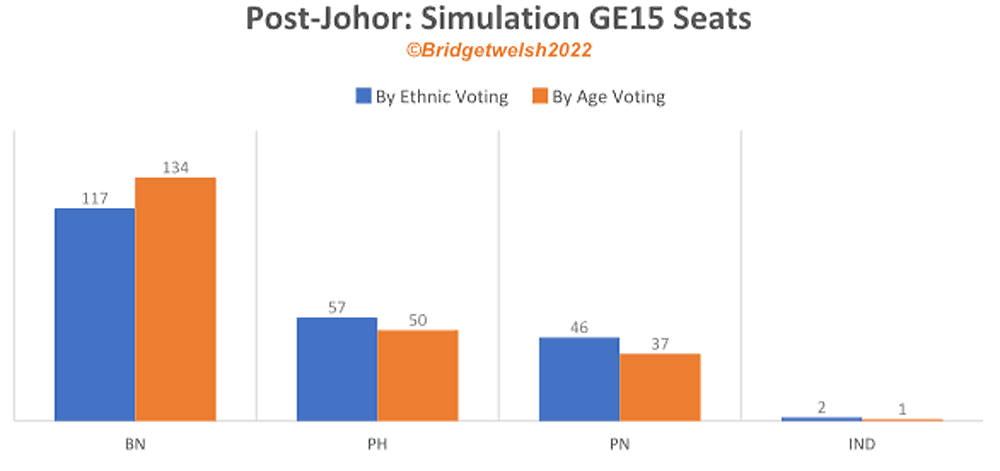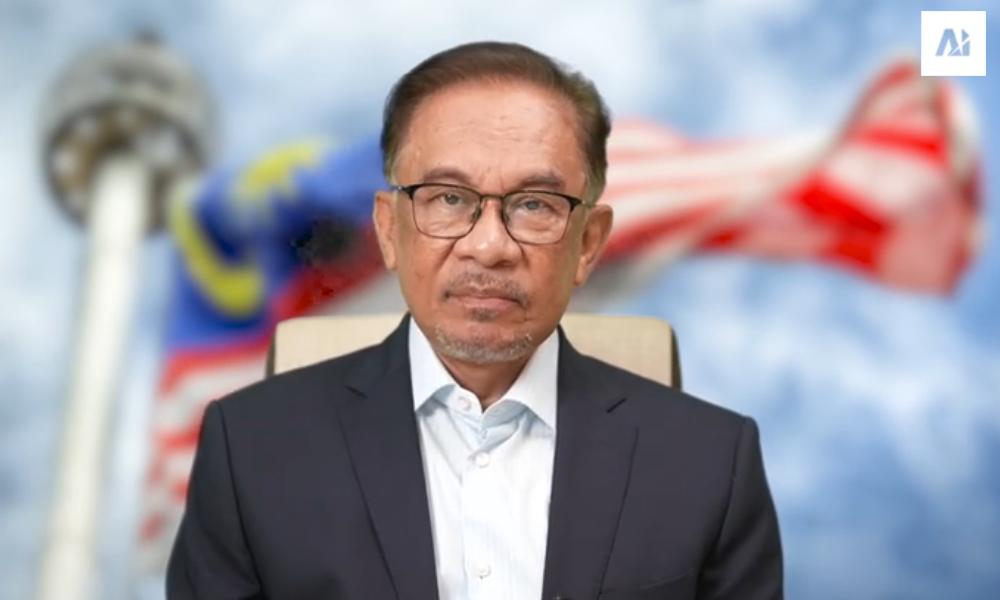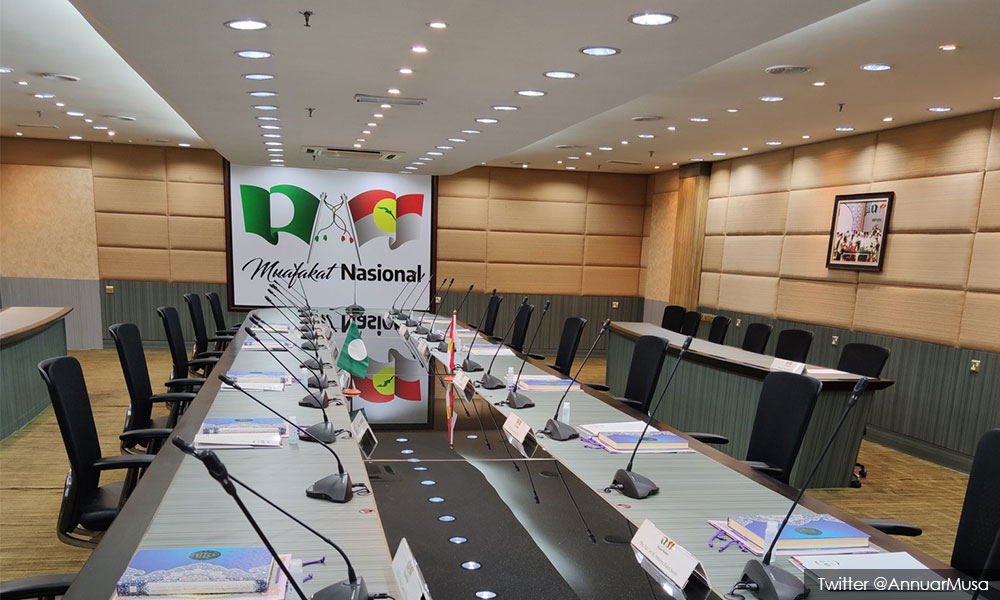All eyes are looking toward Malaysia’s next general election.
While an election minimally is likely months away (and may not even occur this year as an election is only due for 2023), it is useful to look at what current voting trends suggest for the coming GE15.
Based on recent voting, who could win a general election when one is called?
The answer is not hard, given the steady Umno/BN victories in the last four state elections, divisions in the opposition and ongoing display of internal division now evident in the PKR party polls: Umno/BN has a clear advantage.
The projection numbers show this as well; trends from Sabah to Johor show that this advantage has grown since 2020 during the pandemic.
Described below, a simulation of recent voting trends in the 222 parliamentary seats confirms Umno/BN’s current electoral advantage and shows that the opposition faces a tough fight to even hold onto its seats, least of all to win new ones.
Needed caveats
Below, I present the overall results of a simulation from both ethnic and age voting trends in the past four state elections. Before reading the findings, it is important to acknowledge the limitations of these projections.
The analysis does not account for (pull or push factors of) candidates in seats, or is able to confirm who are the parties contesting (as seat allocations have yet to be finalised), or assess the entry of new players/parties.
It draws on older patterns of contestation in the seats and assumes three coalitions will contest as has been the case in the past two state polls.
Perhaps most important, it does not account for the mood of a campaign, which continues to be an important window for influencing voters even as a lower overall share is turning out to vote. In short, a statistical projection leaves out crucial electoral dynamics.
Equally important is the need to recognise that a state election is not a national election. Local dynamics at the state level are unique.

The momentum surrounding a GE is more intense, with coalition resources not concentrated in one location. Also, the opposition traditionally performs better in a GE rather than a state election as this has been their narrative focus.
A classic example of different fortunes is the shift in voting in Sarawak from the BN wins in the 2016 state polls to significant losses in GE14.
Given limitations, the simulation should thus be seen as a broad indication of the electoral strength and weakness of different coalitions/parties currently.
As elections are at their earliest months before they are likely called (at least after the end of the July MOU), a lot can change (or not) between now and then. The last four years have shown clearly that politics in Malaysia can change quickly.
Overall simulation outcome
A little background on the simulation methods: it is based on voting patterns at both the macro and micro levels (polling stations and saluran (streams) and draws from patterns of ethnic and age voting patterns in previous elections, with the emphasis on the last elections in Sabah, Malacca, Sarawak and Johor.
Turnout levels used are 60 percent, higher than Johor, but lower than the other three state elections. Usually (except in Sarawak), voting in a general election is higher than in a state election.
The analysis includes the projected new Undi18 and automatic-registered voters, who will increase the overall voters by around a third (although unevenly across seats due to local demographic differences).
The simulated findings of voting trends point to an Umno/BN victory, ranging from 117 to 134 seats; if trends continue Umno/BN would win a majority and take the helm of government.
Age voting projections point to a higher majority of seats. Both, at this point, suggest less than two-thirds, 148 seats.
Of all the parties in BN, Umno could win the most seats, increasing its current 37 seats by at least 25 seats, depending on how BN allocates seats internally.

Over a third of the seats nationally would turnover, suggesting that the composition of the Parliament and government would change considerably, especially if parties field younger candidates and fewer incumbents which have been the recent trend.
This means that any new government would potentially take time to find its footing, delaying time and focusing on economic recovery.
Electoral drivers of change
Voting trends suggest that the political landscape has changed. Fewer seats are competitive, less than a third of overall seats, as voting trends point to more secure margins (of over 10 percent of the potential vote) in the projected possible victories.
The underlying drivers accounting for these shifts in voting and projected outcomes are four-fold:
Pakatan Harapan’s support has eroded among Indian and Chinese voters and Generation Y/millennial voters, who are not returning to vote for them and, particularly among Indians and Gen Y, voting for alternatives.
Perikatan Nasional has been effective in winning over support from Malay and younger voters under 40. This has meant that Harapan’s quarter of Malay support in GE14 has eroded and the new voters coming on stream are more fragmented among the different electoral alternatives.
While levels of support are not those of the past, Umno/BN exodus in electoral support it was experiencing from 2008 to 2018 has ebbed. While weaker and divided, Umno/BN has the strongest electoral machinery/resources and is able to bring out its supporters more effectively than the alternative coalitions in recent elections.
The opposition is divided and weaker. Harapan is no longer a unified coalition, most evident in Johor but this pattern is being reinforced by persistent divisions in public, both among coalition allies and within parties. Among the many issues currently facing Harapan is poor leadership.
Losers from trends
Not surprisingly, the main projected electoral loser will be Harapan.
The party that faces the most losses if state election trends post-Johor continue is PKR, potentially losing 27 out of its 36 seats, with another two seats also vulnerable.
The simulation suggests that the next GE could not be a return to 2013 for PKR, but (almost) to the defeat of 2004.
Electorally, in terms of projected seat losses, PKR is the weakest link.
Having won only three seats out of the scores it has contested in the last four state elections over the past two years, Anwar Ibrahim’s leadership of Harapan has failed to win electoral support.

If he continues to helm the party and Harapan coalition into the next polls, which appears increasingly likely as he has yet to give way to younger leaders, he could wipe out his own reform legacy.
The potential simulated losses extend across Harapan.
Amanah faces significant losses with potentially nine of its 11 seats at risk of turnover.
DAP will not be spared, with as many as 10 of its 42 seats facing possible losses. Warisan, which is now fighting with its Harapan GE14 allies, risks losing 5 out of 7 seats based on simulated trends.
Divided fortunes for PN
Simulated trends suggest the Islamist party PAS could win all of its current seats (and that of the now independent MP Kuala Nerus), and depending on the negotiations with its coalition partner Bersatu, it may pick up further seats, such as in the competitive seats of Hulu Terengganu or Bukit Gantang.
PAS has gained in seat share in its alliance with Bersatu, gaining an appointed seat in Sabah and winning a seat in Johor. While the party internally is split on who it should ally with, there have been electoral gains in support for the party.
It stands to win the most seats out of the PN alliance. PAS grassroots members still hold onto the view that an alliance with Umno will strengthen their electoral fortunes.
Their argument has validity based on electoral patterns from the 2019 heyday of Muafakat Nasional. Yet the findings also suggest that PAS has gained from being in the Umno/PN government and its alliance with PN since 2020.
Bersatu, by contrast, faces a much harder battler to retain its seats, especially seats it won in multi-ethnic urban areas such as Ampang, although may pick up seats from Harapan depending on its negotiation with its partner PAS and government incumbent resource advantage.
The key will be whether its current leader Muhyiddin Yassin, who has said he will not run for his parliamentary seat, is able to hold this coalition together.

Still powerful Borneo
In contrast, the coalition that looks to have the most favourable advantage is Gabungan Parti Sarawak, favoured to win all of the 18 parliamentary seats it now holds if the electoral outcomes of Sarawak polls continue, and it may also gain seats, such as Sarikei.
Trends suggest that any new Umno/BN government will still depend on the support of parties/coalitions from Sarawak and Sabah.
If age voting trends continue, the importance of Sabah and Sarawak for the Umno/BN majority would be somewhat reduced.
Ongoing transformations
Malaysian politics is transforming again. The situation remains in flux. The viability of coalitions, the unity and leadership of parties all are among the unknowns in the months ahead before the next GE.
There is resistance to an early election. It remains unclear how long this resistance can hold out.
Given infighting, much of the opposition has yet to absorb the projected potential electoral realities. The mode remains defensive and divisive.
Egos and deluded views of the past electoral strength colour steps toward recalibrating to current political conditions.
Of all the parties, the recent electoral victories have most empowered Umno, reducing conflict as the party looks eagerly to potentially winning government.
This has empowered those who have the most personal interests in having an early election, the court cluster. Umno has shown that it will use its influence to push for polls, by hook or crook.
For voters grappling with Covid-19 and a needed economic recovery, elections have taken priority over governance. Not much has changed for them politically.
Malaysia has returned to politicking mode, with the politicians, once again, largely focused on their own political fortunes. - Mkini
BRIDGET WELSH is a senior research associate at the Hu Fu Centre for East Asia Democratic Studies and a senior associate fellow of The Habibie Centre. She currently is an honorary research associate of the University of Nottingham, Malaysia's Asia Research Institute (Unari) based in Kuala Lumpur. She tweets at @dririshsea.
The views expressed here are those of the author/contributor and do not necessarily represent the views of MMKtT.



No comments:
Post a Comment
Note: Only a member of this blog may post a comment.